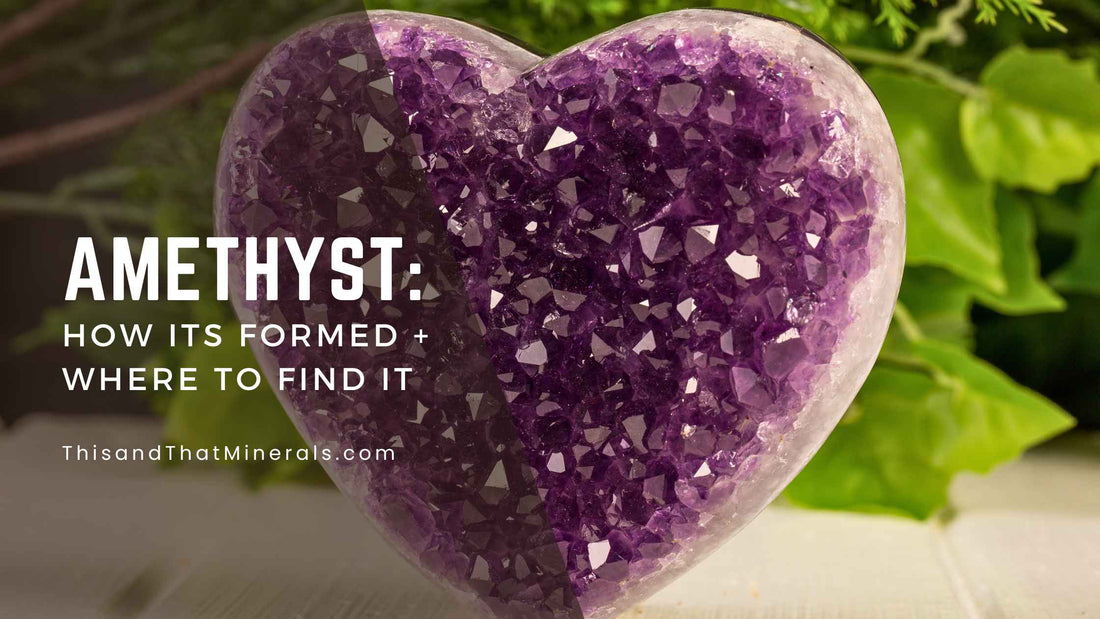
Amethyst: How Its Formed and Where to Find It
Amethyst is one of the world’s most popular and well-recognized gemstones. Amethyst is a variety of quartz known for its rich purple hues that have captivated people across cultures and eras. But what gives amethyst its striking color? How does it form? And where can you find the finest specimens in the world? This article discusses how amethyst is formed and where to find it.
Geological Formation of Amethyst
Amethyst is part of the quartz family, which forms under specific conditions within the Earth’s crust. Quartz, composed of silicon dioxide (SiO₂), forms in various environments, but amethyst develops under a unique combination of elements, pressure, and temperature. Here’s a closer look at how this natural process occurs:
- Hydrothermal Activity: Amethyst forms in areas with volcanic activity, where hydrothermal fluids rich in silica penetrate cavities in rocks. These boiling fluids deposit silicon dioxide crystals over time.
- Iron Infusion: One of the essential elements that gives amethyst its color is iron. As quartz crystals grow in iron-rich environments, traces of iron are incorporated into the crystal structure. Iron doesn’t create a color change in its natural state/
- Gamma Radiation Exposure: The magic of amethyst’s color happens through natural gamma radiation exposure. When quartz containing iron is exposed to radiation, often from nearby rocks containing radioactive elements, the iron ions are rearranged within the crystal. This process creates the purple color associated with amethyst, ranging from pale lavender to deep, royal purple.
- Temperature and Pressure: Amethyst requires a narrow range of temperatures and pressures to form correctly. If the conditions are too hot, the amethyst will lose its purple hue and become citrine. The result is a gem that can vary widely in color, clarity, and crystal formation depending on where it grows.
Read more about how amethyst is formed.
Where Amethyst is Found Around the World
Amethyst can be found on nearly every continent, but certain regions are known for producing exceptionally high-quality and sought-after specimens. Here are some of the world’s most famous amethyst-producing regions:
Brazil
Brazil is a powerhouse in the gemstone world, producing most of the amethyst today. The state of Rio Grande do Sul in southern Brazil is primarily known for its large amethyst geodes, often containing clusters of dark purple crystals. Some Brazilian amethyst geodes are so large they’re used as statement pieces in homes and businesses.
Uruguay
Neighboring Brazil, Uruguay is another major player in the amethyst market, producing some of the deepest purple amethysts in the world. Amethyst from Uruguay is highly prized for its intense color, often richer and darker than Brazilian amethyst. Mines in Artigas, Uruguay, have produced exquisite amethyst geodes with high luster and color saturation, making them highly collectible.
Zambia
African amethyst is known for its unique, dark color with red and blue flashes, giving it a rich appearance. Zambia, in particular, has gained a reputation for producing exceptional amethyst crystals with distinct color zoning and saturation. Zambian amethyst is often used in fine jewelry and is prized for its deep hues.
Russia
Amethyst from the Ural Mountains in Russia has historical significance. It was popular among the Russian nobility and used in royal jewelry. Russian amethyst tends to have lighter shades and can exhibit pinkish undertones. However, due to limited production, it is now relatively rare and valuable.
South Korea
South Korea, specifically the region of Taean, is known for unique amethyst specimens that are typically smaller but boast high clarity. South Korean amethyst was widely mined in the 20th century, though its popularity and mining have since decreased. Due to their unique geographic origin, these gems are now considered collectible.
India
While less well-known than other regions, India also produces amethyst, particularly in Maharashtra. Indian amethyst has a distinct appearance, often exhibiting color zoning and a translucent quality that appeals to collectors and jewelry designers alike.
United States
The United States has several amethyst-producing areas, with Arizona and South Carolina being notable sources. In Arizona, the Four Peaks Mine is famous for producing a beautiful reddish-purple amethyst that rivals some of the finest materials from Brazil or Uruguay. South Carolina’s Ellis-Jones Mine also yields amethyst crystals that vary in color from light to dark purple.
Famous Amethyst Mines and Regions
Some specific mines and regions are famous not only for their quality of amethyst but also for their accessibility to collectors and enthusiasts. Here are a few:
Four Peaks Mine, Arizona, USA: Known for its high-quality reddish-purple amethyst, this mine has been operational since the early 1900s and is the primary source of gem-quality amethyst in the United States.
Artigas Mines, Uruguay: In northern Uruguay, the Artigas mines produce some of the world’s finest deep purple amethyst geodes. The crystals here are often large and have exceptional color saturation, which is rare in other parts of the world.
The Vera Cruz Mine, Mexico: This lesser-known mine in Mexico produces a unique variety of amethyst crystals that are highly transparent and delicate, often pale purple. They are prized for their clarity and luster, making them ideal for jewelry.
Read more about where to find amethyst.
Why Amethyst is Prized Around the World
Amethyst has been treasured for centuries for its beauty, versatility, and metaphysical properties. In ancient Greece, amethyst was associated with Dionysus, the god of wine, and was believed to prevent drunkenness. In the Middle Ages, it became a symbol of piety and royalty, adorning the rings and crowns of clerics and nobles. Today, it’s appreciated for its aesthetic appeal and purported ability to calm the mind, promote clarity, and relieve stress.
The Enduring Appeal of Amethyst
From Brazil's volcanic regions to South Korea's mines, amethyst captures hearts and minds with its mesmerizing purple hues and mystical allure. Whether you’re drawn to it for its beauty, history, or metaphysical properties, amethyst remains a timeless gemstone with roots that stretch back millions of years. Whether you display it in your home, wear it as jewelry, or add it to your collection, amethyst is one of nature’s most captivating creations.
Amethyst’s journey from deep within the Earth to becoming a cherished gemstone reminds us of the beauty and wonder found in the natural world—a beauty that can be shared, admired, and enjoyed by all.
PIN IT

